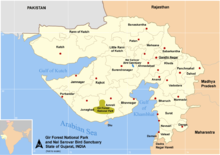Asiatic lion
| Asiatic lion | |
|---|---|
 |
|
| Male | |
 |
|
| Female | |
| Scientific classification | |
| Kingdom: | Animalia |
| Phylum: | Chordata |
| Class: | Mammalia |
| Order: | Carnivora |
| Family: | Felidae |
| Genus: | Panthera |
| Species: | P. leo |
| Subspecies: | P. l. persica |
| Trinomial name | |
|
Panthera leo persica Meyer, 1826 |
|
 |
|
| Current distribution of the Asiatic lion in the wild | |
| Synonyms | |
|
Panthera leo asiaticus |
|
Panthera leo asiaticus
(Brehm, 1829)
Panthera leo bengalensis
(Bennett, 1829)
Panthera leo indica
(Smee, 1833)
Panthera leo goojratensis
(de Blainville, 1843)
The Asiatic lion (Panthera leo persica), also known as the Indian lion and Persian lion, is a lion subspecies that lives as a single population in India's Gujarat State. It is listed as Endangered on the IUCN Red List because of its small population size.
The Asiatic lion was first described by the Austrian zoologist Johann N. Meyer under the trinomen Felis leo persicus. Its historical range included Turkey, Persia, Mesopotamia, and from east of the Indus River in the former Sind Province to Bengal and Nerbudda River in Central India. It differs from the African lion by a less developed mane, a larger tail tuft and less inflated auditory bullae.
Since 2010, the lion population in and around Gir Forest National Park has steadily increased. In May 2015, the 14th Asiatic Lion Census was conducted over an area of about 20,000 km2 (7,700 sq mi); the lion population was estimated at 523 individuals, comprising 109 adult males, 201 adult females and 213 cubs.
Its Persian name 'Shir' is part of many place names in Iran. It is one of five big cat species in India, along with Bengal tiger, Indian leopard, snow leopard and clouded leopard.
...
Wikipedia

